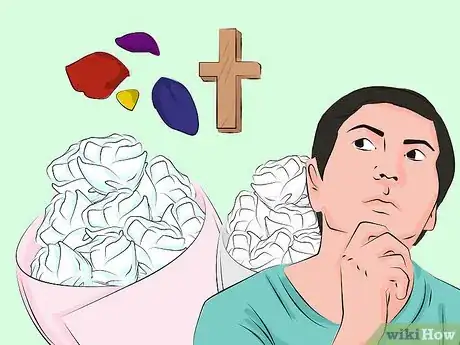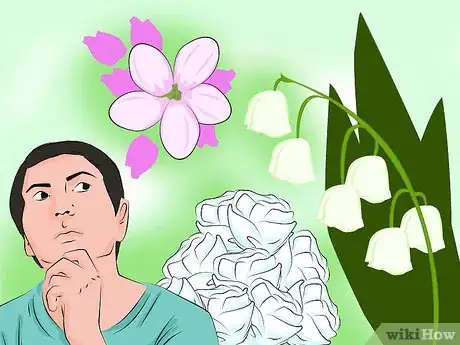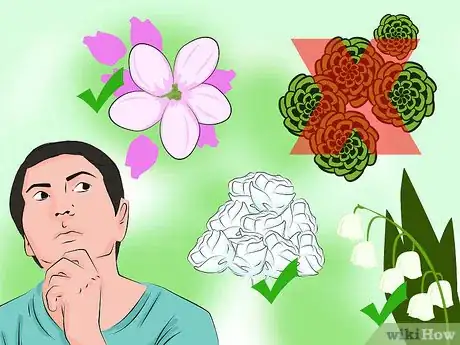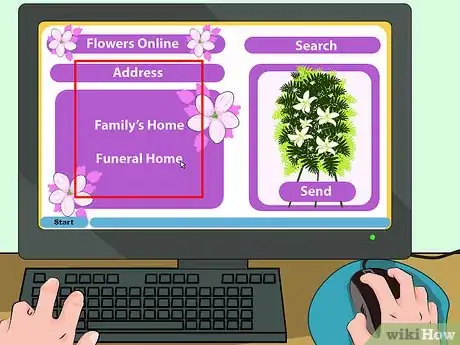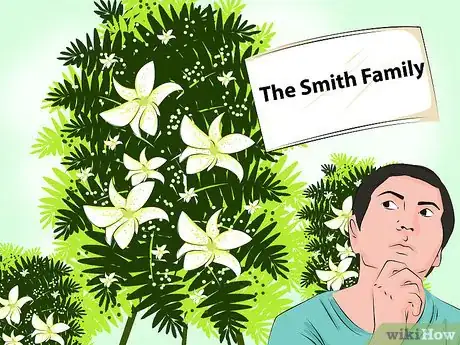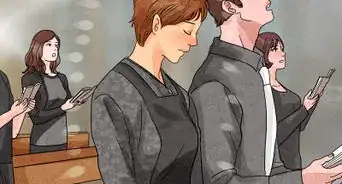This article was co-authored by Jeanne Walker. Jeanne Walker is a Florist and the Owner of Fringe Flower Company, a floral design shop that specializes in weddings, special events, and daily deliveries. Fringe Flower Company, based in Walnut Creek, California, provides customized hand-tied and vase bouquets along with potted plants, succulent gardens, tulip french buckets, and wreaths. Jeanne also conducts floral design workshops and parties throughout the San Francisco Bay Area.
This article has been viewed 167,501 times.
Sending flowers is a common way of expressing sympathy to the family of a deceased individual. Flowers, used to anoint the dead in ancient times and used to adorn the casket and/or burial site today, are meant to comfort those who are grieving and serve as a reminder of the spirit of life. Sending flowers is a wonderful way to let the bereaved know that they are in your thoughts. The flowers you send will hopefully help to celebrate life, provide comfort, and lift the spirit of the relatives of the deceased.[1]
Steps
Choosing the Flowers to Send
-
1Recognize the wishes of the family. Some funeral announcements will say “In lieu of flowers…” and ask for a donation to be made to a favorite charity or a personal cause.
- Some people choose to send flowers in addition to making a donation. This decision is up to you, but when in doubt, respecting the wishes of the family is always appreciated.[2]
-
2Consider the faith of the deceased. The most appropriate flower arrangements can vary depending on the faith, cultural beliefs, or religious traditions of the deceased and the bereaved. What is appropriate in one culture may not be so in another, so it is important to consider this before purchasing flowers for a funeral. Here are some suggestions for more common religious affiliations:[3]
- Catholic and Protestant Christian: there are no specific recommendations or styles to avoid; nearly all colors and types flowers and floral arrangements are acceptable.
- Mormon: while most flowers are acceptable, avoid arrangements with crucifixes or crosses.
- Greek Orthodox: while most flowers are accepted, white flowers are often chosen as a preferred option.
- Jewish: flowers are not typically displayed at a funeral home where the service for the deceased is held; instead, it is more common to send flowers to the family members’ homes. However, you should not take flowers to a Jewish home sitting Shiva.[4]
- Baha’i: most types of flower arrangements are acceptable; there are no specific recommendations or styles to avoid.
- Buddhist: most types of flower arrangements are acceptable; there are no specific recommendations or styles to avoid.
- Hindu: instead of floral arrangements, garlands are more commonly seen at Hindu funerals. Ask the funeral home about the possibility of sending a garland instead.
- Muslim: the acceptability of flowers at an Islamic funeral varies across the faith, and therefore it is important to ask about the desires of the bereaved before sending them.
Advertisement -
3Consider your relation to the deceased. Different types of floral arrangements are sent by individuals with different familial proximity to the deceased. Consider this when choosing an arrangement of flowers to send.
- Choose a casket spray or wreath if you are from the immediate family. Alternate arrangements from immediate family can include table arrangements, swags inside the casket lid, and heart-shaped arrangements.[5]
- Choose a standing spray or informal arrangement if you are a member of the extended family.
- Send a spray, wreath, basket arrangement, bouquet in a vase, or a live plant if you are a close friend or colleague. Friends can send flowers directly to the funeral home or to the home of the family member that they wish to comfort, while business associates can have flowers delivered to the work of the family member.[6]
-
4Make a tribute to the personality of the deceased. Flowers can be used as a way to subtly recognize that which the deceased loved to do in life. Choosing a unique bouquet with a special meaning to you is a great way to honor the life of the deceased.[7]
- If the deceased loved the outdoors, send a basket of rustic wildflowers.
- If the deceased always dressed in yellow, consider sending a bouquet of yellow flowers.
- If the deceased was an avid gardener, consider sending a plant that can be planted by the family outdoors to honor their loved one. Potted plants have symbolic meaning because they will continue to live and grow.[8]
-
5Choose your flowers carefully. While there is no hard and fast rule regarding the types of flowers that should be sent to funerals or homes of the bereaved, there are many traditional favorites. Here are a few suggestions of flowers with meanings that may be appropriate for the funeral setting:
- Apple Blossom: better things to come
- Lilies of the Valley: return of happiness
- Ivy: eternal fidelity
- Hybrid tea roses: “I’ll remember you”
- Roses (red): love/respect/courage
- Roses (pink): grace/gentility
- Roses (light pink): admiration/sympathy
- In addition, certain flowers may be appreciated by certain cultures. For example, Chrysanthemums may be especially appreciated by Asian families.[9]
-
6Consider color meanings. When choosing flowers, especially for an emotional event like a funeral, it is advisable to consider flower colors, as these may be noticed by some of the deceased’s loved ones.
- Pick white flowers to represent peace and reverence.
- Choose blue flowers to represent comfort and calm.
- Avoid green flowers. These represent health and good fortune, a meaning which is not appropriate for the event at hand.
- Red flowers should be avoided at Buddhist funerals. Instead, white flowers are preferred.[10]
Purchasing and Sending Flowers
-
1Consult the funeral home about any rules they may have regarding flowers. For example, many funeral homes have rules about sending floral arrangements in vases that may be prone to tip over and spill and/or break. This includes glass vases. If in doubt, call the funeral home to ask if there are any preferred ways to display flowers so that you can convey this when you place your flower order.
-
2Visit a local florist. Visiting a local florist can be a great way to make sure you are sending the right type and right arrangement of flowers. Florists will often be quite well-versed in composing various types of floral arrangements for funerals. If you are from a small town, the florist may know the deceased or bereaved personally and may be able to offer additional advice.
- Provide the florist with information about the deceased, including the name and the date, time, and location of the funeral service.
- Prepare your message for the card that will be sent with your arrangement. The most common and simple note is “I’m/We’re sorry for your loss” or “With deepest sympathy.” However, you may choose to write a longer and more personalized message.
-
3Send flowers from an online website. Sending flowers from an online website has become increasingly common and may be more convenient than making a trip to a local florist. Most online flower ordering sites have a link to order sympathy and funeral arrangements online, where you can add in all the same information that you would tell your florist.
-
4Visit www.teleflora.com to order standing sprays and wreaths, funeral service bouquets, sympathy bouquets, photo and urn tributes, and flower arrangements for the caskets. This website will deliver to the location where the funeral service will be held or to the family’s home.
- Try www.ftd.com to order plants as well as flowers, sprays, and wreaths. FTD has a very nice collection of potted plants to choose from if that is what you desire.
- Visit www.1800flowers.com and choose “Sympathy for Funeral Service” to choose an arrangement of funeral flowers that fits your taste and budget.
-
5Decide where to send your floral arrangement. While most floral arrangements are sent directly to the funeral home that will hold the viewing of the deceased, it is also appropriate to send flowers to the family’s home.
-
6Consider including others in your floral commemoration. Many times, groups of friends, such as a social club, a luncheon group, or business colleagues, decide to send a floral tribute as a group. When a group of individuals go in together on the purchase of a floral arrangement, it can often be larger and potentially more noticeable than many small arrangements.
- Sign the card with the flowers as a group, for example, “The Accounting Group at X Business” or “The Smith Family.”
Community Q&A
-
QuestionI want to make a wreath out of mums for the funeral. How many days in advance can I make it?
 Community AnswerFor best results, make the wreath the day before the funeral.
Community AnswerFor best results, make the wreath the day before the funeral. -
QuestionIs it appropriate to send 1 rose to a funeral?
 Community AnswerThe cost of having a single rose delivered offsets the practicality, but you could do so. Some people bring a single rose and leave it during the funeral.
Community AnswerThe cost of having a single rose delivered offsets the practicality, but you could do so. Some people bring a single rose and leave it during the funeral. -
QuestionWhat print on the ribbon conveys your sympathy for extended family?
 Community AnswerIt would be best to just keep the ribbon plain to keep it appropriate for the serious circumstances. If you want to convey your sympathy, you can attach a small sympathy card/note to the bouquet.
Community AnswerIt would be best to just keep the ribbon plain to keep it appropriate for the serious circumstances. If you want to convey your sympathy, you can attach a small sympathy card/note to the bouquet.
References
- ↑ http://etiquette.about.com/od/Funeral/a/Proper-Etiquette-For-Sending-Funeral-Flowers.htm
- ↑ http://www.freitagfuneralhome.com/publications/funeraletiquette.htm
- ↑ http://etiquette.about.com/od/Funeral/a/Proper-Etiquette-For-Sending-Funeral-Flowers.htm
- ↑ http://www.teleflora.com/funeral-sympathy-collection/funeral-customs-religious
- ↑ http://etiquette.about.com/od/Funeral/a/Proper-Etiquette-For-Sending-Funeral-Flowers.htm
- ↑ http://etiquette.about.com/od/Funeral/a/Proper-Etiquette-For-Sending-Funeral-Flowers.htm
- ↑ Jeanne Walker. Florist. Expert Interview. 15 April 2020.
- ↑ https://www.funeralwise.com/etiquette/flowers/
- ↑ http://www.teleflora.com/funeral-sympathy-collection/funeral-customs-religious
About This Article
Buying flowers for a funeral is a common way of expressing sympathy and respect to the family of the deceased. Before you go flower-shopping, check the funeral invite for any preferences about flowers and where you should send them. If you’re immediate family, it’s common to send a casket spray or wreath. If you’re extended family, send a standing spray or informal arrangement. If you’re a close friend or colleague, send a spray, wreath, basket arrangement, or bouquet. In general, choose white flowers to represent peace and reverence or blue for comfort and calm. Avoid green flowers for funerals. To buy your flowers, visit a local florist or search online if you’re busy. Unless the family have a preference, you can send them to either the funeral home or their family home. For more tips, including how to choose flowers for different religious funerals, read on.

